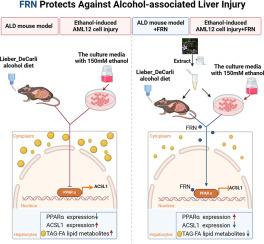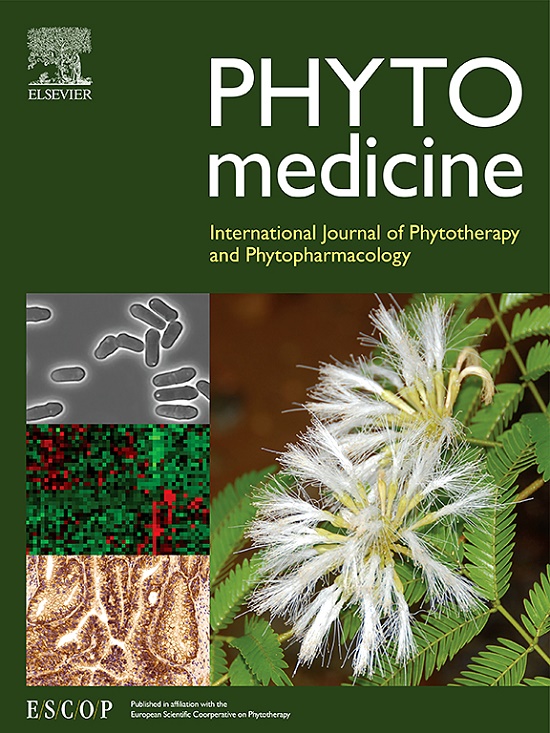Flavonoids from Rhododendron nivale Hook. f ameliorate alcohol-associated liver disease via activating the PPARα signaling pathway
IF 6.7
1区 医学
Q1 CHEMISTRY, MEDICINAL
引用次数: 0
Abstract
Background
Flavonoids are increasingly recognized for their potent antioxidant properties and potential therapeutic roles in the management of alcohol-associated liver disease (ALD). Extracts derived from Rhododendron nivale Hook. f. (FRN) have been shown to influence glutathione metabolism in aging animal models, exhibiting notable antioxidant effects. However, the specific impact of FRN on ALD remains insufficiently explored.
Hypothesis/Purpose
This study seeks to elucidate the efficacy of FRN in alleviating the pathology associated with ALD, delving into the underlying molecular mechanisms that facilitate its protective effects.
Study Design
We employed network pharmacology to predict the functional roles and pathway enrichments associated with FRN targets. Both a murine model of ALD and in vitro cellular models were utilized to clarify the mechanistic basis by which FRN mitigates ALD.
Methods
FRN was extracted and characterized according to well-established methodologies outlined in our previous studies. Potential functions and pathways implicated by FRN were predicted through network pharmacology analyses. A combination of liver transcriptomics, targeted lipidomics, molecular biology techniques, and antagonists of relevant targets were employed to investigate the mechanisms through which FRN exerts its protective effects in ALD.
Results
Network pharmacology identified multiple target genes modulated by FRN, particularly those within critical ALD-related signaling pathways, such as PPARα signaling and fatty acids (FAs) degradation. Notably, treatment with FRN in the ALD murine model led to a significant attenuation of hepatic lipid accumulation and a restoration of serum AST and ALT to baseline ranges. Subsequent validation through liver transcriptomics and molecular biology techniques revealed an upregulation of PPARα expression concomitant with a downregulation of ACSL1 in FRN-treated ALD mice. Targeted lipidomic and bioinformatic analyses demonstrated that FRN substantially reduced the accumulation of long-chain fatty acids in hepatocytes. Importantly, the reversal of FRN's protective effects on lipid accumulation through the PPARα antagonist GW6471 provides compelling evidence for the critical role of PPARα signaling modulation in mediating the beneficial impact of FRN on ALD.
Conclusion
Our research highlights FRN's capacity to alleviate ALD through PPARα pathway activation, paving the way for innovative treatment strategies. This underscores the significance of natural compounds in pharmacotherapy, suggesting that FRN may provide an effective alternative for managing ALD.

通过激活 PPARα 信号通路改善酒精相关肝病
背景类黄酮因其强大的抗氧化特性和在治疗酒精相关性肝病(ALD)中的潜在治疗作用而日益得到认可。从黑皮杜鹃花(Rhododendron nivale Hook. f.,FRN)中提取的提取物已被证明能影响衰老动物模型的谷胱甘肽代谢,表现出显著的抗氧化作用。研究设计我们采用网络药理学来预测与 FRN 靶点相关的功能作用和通路富集。我们利用小鼠 ALD 模型和体外细胞模型来阐明 FRN 缓解 ALD 的机理基础。通过网络药理学分析预测了 FRN 的潜在功能和作用途径。结合肝脏转录组学、靶向脂质组学、分子生物学技术和相关靶点的拮抗剂,研究了FRN在ALD中发挥保护作用的机制。结果网络药理学发现了多个受FRN调控的靶基因,尤其是那些与ALD相关的关键信号通路中的靶基因,如PPARα信号转导和脂肪酸(FAs)降解。值得注意的是,在 ALD 小鼠模型中使用 FRN 治疗后,肝脏脂质积累明显减少,血清 AST 和 ALT 恢复到基线范围。随后通过肝脏转录组学和分子生物学技术进行的验证显示,在 FRN 治疗的 ALD 小鼠中,PPARα 表达上调,同时 ACSL1 下调。靶向脂质组学和生物信息学分析表明,FRN 大大减少了肝细胞中长链脂肪酸的积累。重要的是,通过 PPARα 拮抗剂 GW6471 逆转 FRN 对脂质积累的保护作用提供了令人信服的证据,证明 PPARα 信号调节在介导 FRN 对 ALD 的有益影响方面起着关键作用。这凸显了天然化合物在药物治疗中的重要作用,表明 FRN 可为治疗 ALD 提供一种有效的替代方法。
本文章由计算机程序翻译,如有差异,请以英文原文为准。
求助全文
约1分钟内获得全文
求助全文
来源期刊

Phytomedicine
医学-药学
CiteScore
10.30
自引率
5.10%
发文量
670
审稿时长
91 days
期刊介绍:
Phytomedicine is a therapy-oriented journal that publishes innovative studies on the efficacy, safety, quality, and mechanisms of action of specified plant extracts, phytopharmaceuticals, and their isolated constituents. This includes clinical, pharmacological, pharmacokinetic, and toxicological studies of herbal medicinal products, preparations, and purified compounds with defined and consistent quality, ensuring reproducible pharmacological activity. Founded in 1994, Phytomedicine aims to focus and stimulate research in this field and establish internationally accepted scientific standards for pharmacological studies, proof of clinical efficacy, and safety of phytomedicines.
 求助内容:
求助内容: 应助结果提醒方式:
应助结果提醒方式:


